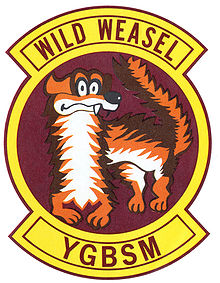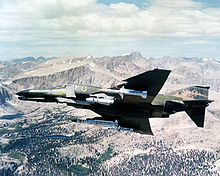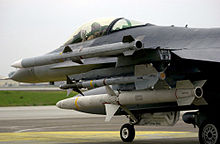Wild Weasel
Wild Weasel is an unofficial designation for United States Air Force aircraft tasked with Suppression of Enemy Air Defences. The name comes from the Wild Weasel project, the first development program for air defense and radar countermeasures aircraft. The Wild Weasel concept was developed during the Vietnam War specifically to counter the large number of North Vietnamese radar-guided surface-to-air missiles (SAMs).
In the field, fire-control radars are searched for emissions or the Wild Weasel aircraft is provoked in order to determine the position by means of triangulation and then to mark it. Afterwards, the radar image is combated either with missiles that have a special seeker head (Anti-Radiation Missile (ARM)) that reacts to the radar's transmission impulses, for example AGM-45 Shrike, AGM-78 Standard ARM, AGM-88 HARM (High-Speed ARM) or, in some cases, with conventional armament. Missions are usually flown in a 4-man formation or two 2-man formations, with one part playing "decoy" while the other part does the attacking; this division is also called the "Hunter-Killer Team". When the bombing of North Vietnam resumed in 1972 as part of Operation Linebacker, mixed formations of two F-105Gs and two F4s flew. Here, the F-105Gs acted as "hunters," which were tasked with identifying and engaging radar. The "Killer" component flew F-4D/E Phantoms and attacked the marked SAM positions with conventional bombs to destroy launchers and missiles. Due to the dangerous nature of these missions, only volunteer pilots were trained for the Wild Weasel task. The unofficial motto of the crews became YGBSM (You Gotta Be Shittin' Me), which was supposedly the standard statement of the first Wild Weasel EWOs (Electronic Warfare Officers) when they learned what the Wild Weasel concept entailed. The tactic against already approaching anti-aircraft missiles consisted of first flying towards them and then evading them in a sharp turn shortly before entering the range of the warhead. On the one hand there was the danger that the aircraft was damaged or destroyed if the evasive maneuver was initiated too late, but if the maneuver was initiated too early, the anti-aircraft missile could follow the aircraft. If several SAM missiles were fired, there was a danger that one aircraft would have to evade several missiles or that several aircraft would have to fly evasive manoeuvres at the same time, creating a risk of collision.
The first aircraft to be upgraded for this role in 1965 was the F-100F Wild Weasel I. Since the F-100 did not have the performance characteristics to survive in such a hazardous environment, the role was taken over by the Republic F-105 Thunderchief in the summer of 1966 in variant F (Wild Weasel II) and later in the upgraded variant G (Wild Weasel III). However, due to the cessation of F-105 production in 1964, a successor had to be sought and was found in the F-4C Phantom II, designated Wild Weasel IV. Eventually, the E variant formed the basis for the best known and most successful Wild Weasel configuration, the F-4G Wild Weasel V, which began its missions in 1978. It remained in service as the last Phantom version within the USAF until 1996, working alongside the F-16 Fighting Falcon in the "Hunter-Killer Team". Today, the Wild Weasel role is performed only by the F-16 CJ Block 50/52 (also stationed at Spangdahlem Air Base in Germany, among other locations), also known as the SAM Hunter.

Wild Weasel patch with YGBSM lettering

An F-4G with AGM-88 HARM, AGM-65 Maverick, ALQ-119 ECM jammer, AGM-78 Standard ARM and AGM-45 Shrike, photographed circa 1981.
Engineering
The F-4G Wild Weasel V - also known as the Advanced Wild Weasel - had its M61A1 20mm cannon removed and replaced with front and side-facing antennas for the AN/APR-38 radar warning system. This system could detect and identify fire-control radar systems and sort them according to programmed priorities. The displays of the EWO located in the rear seat consisted of a so-called plan position display to indicate the range and direction of each air defense radar, a panoramic analysis display for type identification as well as marking the highest priority of each apprehended threat, and an extended target marking display. The former gun pod below the nose was fitted with an air intake to provide cooling for the avionics systems installed there. The main radar was the F-4E's AN/APQ-120 with a new processor. A total of 52 transmit or receive antennas for the Wild Weasel task were on the aircraft.
The Wild Weasels during Desert Storm
The 35th Tactical Fighter Wing (TFW) from George AFB, California, and the 52nd TFW from Spangdahlem, Germany, deployed to Sheik Isa AFB in Bahrain and Incirlik Air Base in Turkey to operate within Operation Desert Storm. In accordance with the Wild Weasel concept, the F-4Gs, in cooperation with the F-16, bombed a corridor of Iraqi anti-aircraft missile positions for subsequent bomber units and destroyed air force radar installations and control centers. In the process, a single F-4G was lost, and only because it missed the refueling plane and was unable to make an emergency landing at Al-Kharj Air Base in Saudi Arabia due to fuel shortages as well as fog and failed lighting. The crew managed to eject.
Due to the success of the Wild Weasel during the Second Gulf War, the F-4G was still used in the no-fly zones during Operation Southern Watch (protection of the Shiite population) as well as Operation Provide Comfort II (protection of the Kurdish population).

An AGM-88 HARM (bottom) next to an AIM-9 (middle) and AIM-120 (top) on an F-16C
Questions and Answers
Q: What is a Wild Weasel in the United States Air Force?
A: A Wild Weasel is a nickname for an aircraft in the United States Air Force.
Q: What is the function of a Wild Weasel?
A: The function of a Wild Weasel is to destroy enemy anti-aircraft guns, surface-to-air missiles, and other ground attack weapons.
Q: How does a Wild Weasel locate enemy weapons?
A: A Wild Weasel locates enemy weapons by seeking them out with radar.
Q: How does a Wild Weasel destroy enemy weapons?
A: A Wild Weasel destroys enemy weapons with missiles.
Q: Is the Wild Weasel designed for air-to-air combat?
A: No, the Wild Weasel is not designed for air-to-air combat.
Q: What is the significance of the nickname "Wild Weasel"?
A: The nickname "Wild Weasel" reflects the aggressive and dangerous nature of the mission to seek out and destroy enemy weapons.
Q: What types of ground attack weapons can a Wild Weasel destroy?
A: A Wild Weasel can destroy enemy anti-aircraft guns, surface-to-air missiles, and other ground attack weapons.
Search within the encyclopedia